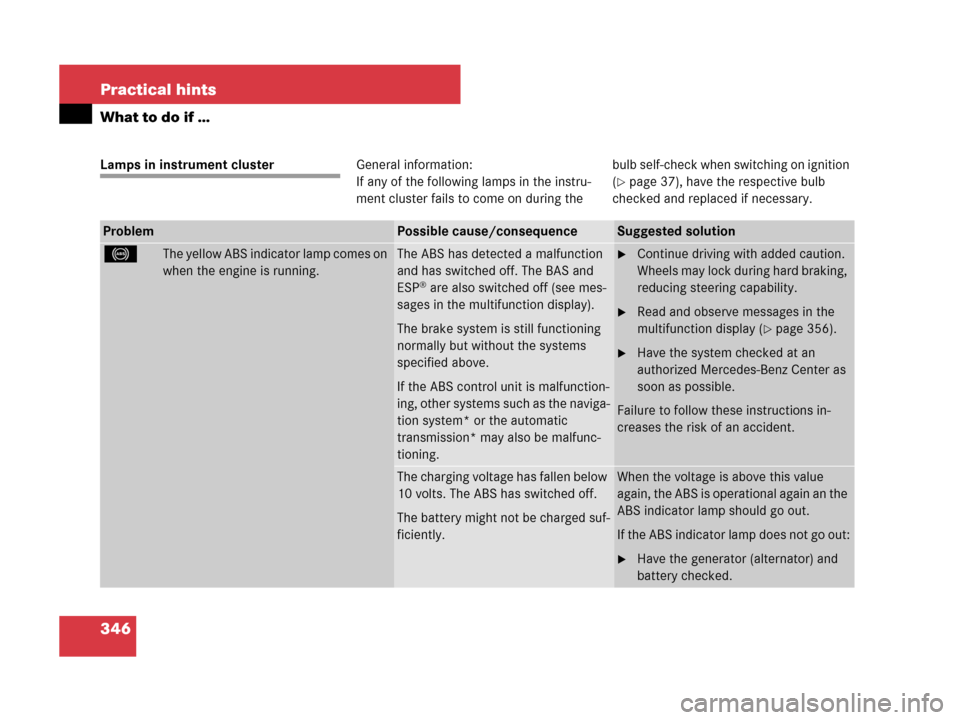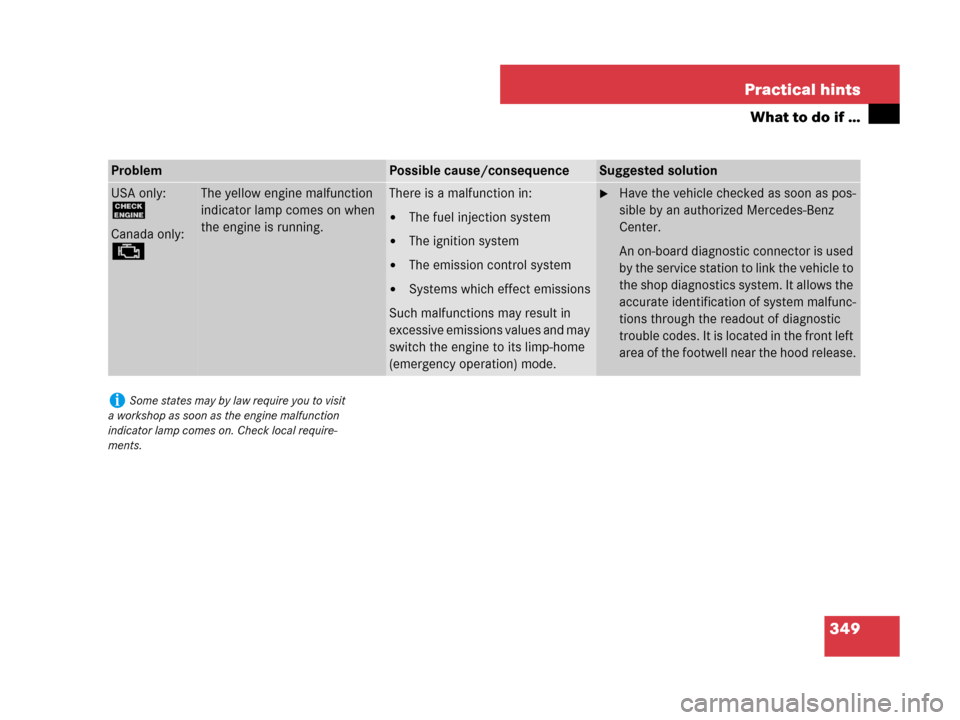Page 300 of 473

299 Operation
Engine compartment
�Pull out oil dipstick1 again after
approximately 3 seconds to obtain
accurate reading.
The oil level is correct when it is be-
tween the lower (min) mark3 and
upper (max) mark2 of oil dipstick1.
�If necessary, add engine oil.
For adding engine oil, see “Adding
engine oil” (
�page 299).
For more information on engine oil, see
“Fuels, coolants, lubricants, etc.”
(
�page 443).
For more information on messages in the
multifunction display concerning engine
oil, see the “Practical hints” section
(
�page 356).Adding engine oil
Only use approved engine oils and oil fil-
ters required for vehicles with
Maintenance System. For a listing of
approved engine oils and oil filters, refer to
the Factory Approved Service Products
pamphlet (USA only) in your vehicle litera-
ture portfolio, or contact an authorized
Mercedes-Benz Center.
Using engine oils and oil filters of
specification other than those expressly
required for the Maintenance System, or
changing of oil and oil filter at change inter-
vals longer than those called for by the
Maintenance System will result in engine
or emission control system damage not
covered by the Mercedes-Benz Limited
Warranty.
SLK 350 (example illustration)
1Filler cap
SLK 55 AMG
1Filler cap
iThe filling quantity between the upper and
lower marks on the oil dipstick is approximately
2.1 US qt. (2.0 l).
Page 318 of 473

317 Operation
Tires and wheels
Potential problems associated with
underinflated and overinflated tires
Underinflated tires
Underinflated tires can:
�cause excessive and uneven tire wear
�adversely affect fuel economy
�lead to tire failure from being
overheated
�adversely affect handling
characteristicsOverinflated tires
Overinflated tires can:
�adversely affect handling
characteristics
�cause uneven tire wear
�be more prone to damage from road
hazards
�adversely affect ride comfort
�increase stopping distance
MOExtended system*
The MOExtended system allows you to
continue driving your vehicle even if there
is a total loss of pressure in one or more
tires.
You may only use the MOExtended system
in conjunction with the Run Flat Indicator*.
For information on driving in case of pres-
sure loss in one or more tires (emergency
mode), see the “Practical hints” section
(
�page 414).
Warning!G
Follow recommended tire inflation
pressures.
Do not underinflate tires. Underinflated tires
wear excessively and/or unevenly,
adversely affect handling and fuel economy,
and are more likely to fail from being
overheated.
Warning!G
Follow recommended tire inflation
pressures.
Do not overinflate tires. Overinflated tires
can adversely affect handling and ride
comfort, wear unevenly, increase stopping
distance, and result in sudden deflation
(blowout) because they are more likely to
become punctured or damaged by road
debris, potholes etc.
Page 332 of 473

331 Operation
Tires and wheels
If applicable to your vehicle’s tire configu-
ration, tires can be rotated according to
the tire manufacturer’s recommended in-
tervals in the tire manufacturer’s warranty
pamphlet located in your vehicle literature
portfolio. If none is available, tires should
be rotated every 3 000 to 6 000 miles
(5 000 to 10 000 km), or sooner if neces-
sary, according to the degree of tire wear.
The same rotation (spinning) direction
must be maintained (
�page 307).
Rotate tires before the characteristic tire
wear pattern becomes visible (shoulder
wear on front tires and tread center wear
on rear tires).
Thoroughly clean the mounting face of
wheels and brake discs, i.e. the inner side
of the wheels/tires, during each rotation.
Check for and ensure proper tire inflation
pressure.For information on wheel change, see the
“Practical hints” section (
�page 385) and
(
�page 401).
Warning!G
Have the tightening torque checked after
changing a wheel. Wheels could become
loose if not tightened with a torque of
80 lb-ft (110 Nm).
Only use genuine Mercedes-Benz wheel
bolts specified for your vehicle’s rims.
Page 346 of 473
345 Practical hints
What to do if …
Where will I find...?
Unlocking/locking in an emergency
Opening/closing in an emergency
Replacing SmartKey batteries
Replacing bulbs
Replacing wiper blades
Flat tire
Battery
Jump starting
Towing the vehicle
Fuses
Page 347 of 473

346 Practical hints
What to do if …
Lamps in instrument clusterGeneral information:
If any of the following lamps in the instru-
ment cluster fails to come on during thebulb self-check when switching on ignition
(
�page 37), have the respective bulb
checked and replaced if necessary.
ProblemPossible cause/consequenceSuggested solution
-The yellow ABS indicator lamp comes on
when the engine is running.The ABS has detected a malfunction
and has switched off. The BAS and
ESP
® are also switched off (see mes-
sages in the multifunction display).
The brake system is still functioning
normally but without the systems
specified above.
If the ABS control unit is malfunction-
ing, other systems such as the naviga-
tion system* or the automatic
transmission* may also be malfunc-
tioning.
�Continue driving with added caution.
Wheels may lock during hard braking,
reducing steering capability.
�Read and observe messages in the
multifunction display (
�page 356).
�Have the system checked at an
authorized Mercedes-Benz Center as
soon as possible.
Failure to follow these instructions in-
creases the risk of an accident.
The charging voltage has fallen below
10 volts. The ABS has switched off.
The battery might not be charged suf-
ficiently.When the voltage is above this value
again, the ABS is operational again an the
ABS indicator lamp should go out.
If the ABS indicator lamp does not go out:
�Have the generator (alternator) and
battery checked.
Page 348 of 473
347 Practical hints
What to do if …
ProblemPossible cause/consequenceSuggested solution
-The yellow ABS indicator lamp comes on
when the engine is running.The ABS is temporary not available.
The ESP® and the BAS are also un-
available.
The system’s self-diagnosis may not
be completed yet.
The brake system is still functioning
normally but without the systems
specified above.
�Drive a short distance with added
caution at a vehicle speed of above
12 mph (20 km/h).
When the ABS indicator lamp goes
out, the ABS, the ESP
®, and the BAS
are available again.
If the yellow ABS indicator lamp does not
go out:
�Continue driving with added caution.
�Have the system checked at an
authorized Mercedes-Benz Center as
soon as possible.
Failure to follow these instructions
increases the risk of an accident.
Page 349 of 473

348 Practical hints
What to do if …
ProblemPossible cause/consequenceSuggested solution
USA only:
?
Canada only:
±
The red brake warning lamp
comes on when the engine is
running and an acoustic warning
sounds.You are driving with the parking brake
set.�Release the parking brake (�page 53).
The red brake warning lamp
comes on when the engine is
running.There is insufficient brake fluid in the
reservoir.Risk of accident!
�Carefully stop the vehicle in a safe loca-
tion or as soon as it is safe to do so.
�Apply the parking brake (�page 59).
�Read and observe messages in the dis-
play (
�page 356).
�Contact an authorized Mercedes-Benz
Center.
Do not add brake fluid! This will not solve
the problem.
Warning!G
Driving with the brake warning lamp illumi-
nated can result in an accident. Have your
brake system checked immediately if the
brake warning lamp stays on.
Do not add brake fluid before checking the
brake system. Overfilling the brake fluid
reservoir can result in spilling brake fluid on
hot engine parts and the brake fluid catch-
ing fire. You can be seriously burned.!If you find that the brake fluid in the brake
fluid reservoir has fallen to the minimum mark or
below, have the brake system checked for brake
pad thickness and leaks.
Page 350 of 473

349 Practical hints
What to do if …
ProblemPossible cause/consequenceSuggested solution
USA only:
?
Canada only:
±
The yellow engine malfunction
indicator lamp comes on when
the engine is running.There is a malfunction in:
�The fuel injection system
�The ignition system
�The emission control system
�Systems which effect emissions
Such malfunctions may result in
excessive emissions values and may
switch the engine to its limp-home
(emergency operation) mode.
�Have the vehicle checked as soon as pos-
sible by an authorized Mercedes-Benz
Center.
An on-board diagnostic connector is used
by the service station to link the vehicle to
the shop diagnostics system. It allows the
accurate identification of system malfunc-
tions through the readout of diagnostic
trouble codes. It is located in the front left
area of the footwell near the hood release.
iSome states may by law require you to visit
a workshop as soon as the engine malfunction
indicator lamp comes on. Check local require-
ments.